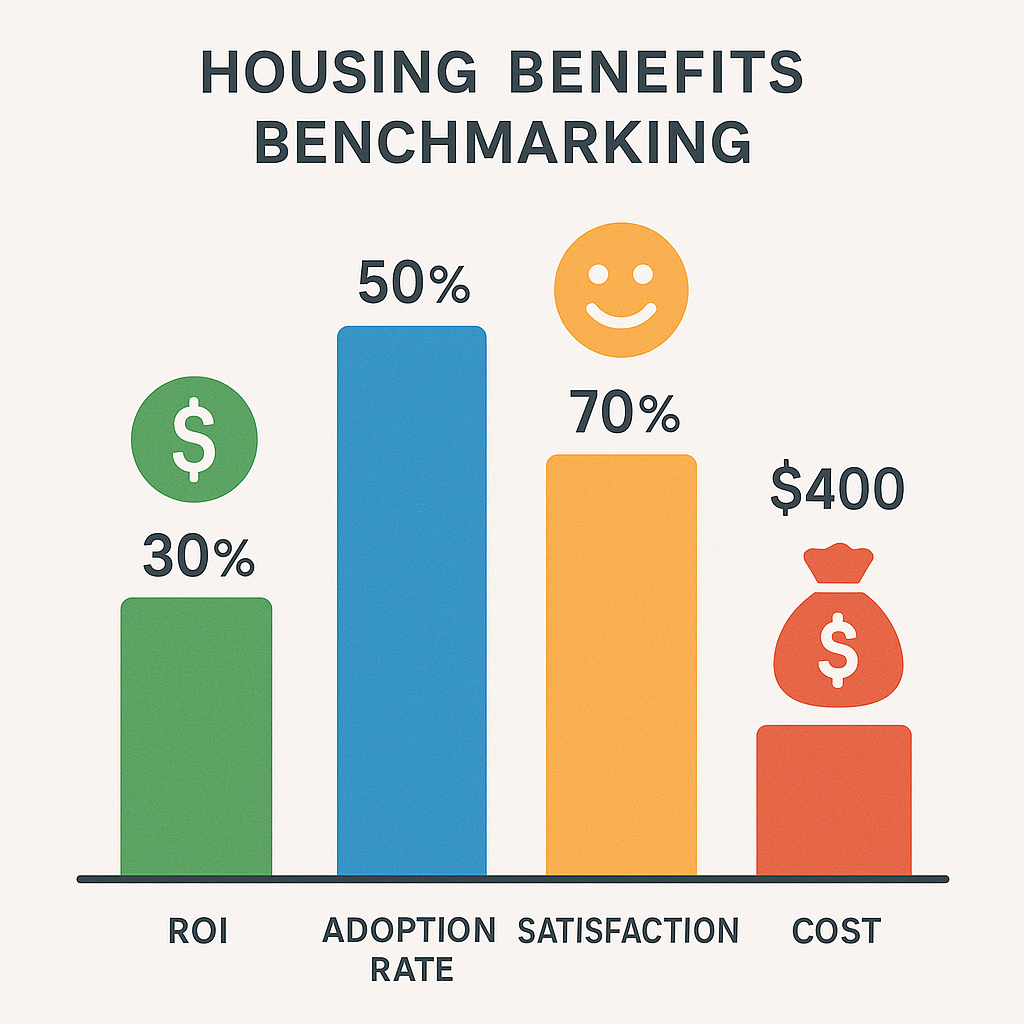Blog > Benchmarking Employee Housing Benefits: Key Metrics & Program Comparisons
Benchmarking Employee Housing Benefits: Key Metrics & Program Comparisons
by

Executive Summary: Benchmarking Framework
Effective benchmarking of employee housing benefits enables HR leaders to compare program performance across critical metrics such as adoption rate, ROI, satisfaction, and cost efficiency. This guide outlines a structured benchmarking framework that applies data-driven methodologies to identify best-in-class programs, uncover performance gaps, and inform strategic improvements for elevated benefit impact.
Key Performance Metrics for Housing Benefits
- Adoption Rate: Percentage of eligible employees enrolled in the program
- ROI: Financial return measured by retention cost savings versus program investment
- Satisfaction Score: Employee satisfaction rating post-transaction
- Time-to-Value: Average time from program announcement to employee home purchase
- Cost per Employee: Total program cost divided by number of participants
Data Collection and Analysis Methodologies
Benchmarking requires consistent data collection protocols, including:
- Surveys: Employee surveys for satisfaction and adoption insights
- System Analytics: Platform data for enrollment and usage tracking
- Financial Records: Detailed cost and savings documentation
- Comparative Analysis: Cross-company data sharing and anonymized benchmarking networks
- Data Normalization: Adjusting metrics for company size and demographics
Comparative Program Feature Matrix
| Program | Adoption Rate | ROI (%) | Satisfaction | Cost/Employee |
|---|---|---|---|---|
| Company A | 78% | 312% | 9.2/10 | $1,200 |
| Company B | 65% | 278% | 8.7/10 | $1,500 |
| Industry Average | 71% | 295% | 8.9/10 | $1,350 |
ROI and Adoption Benchmarks
High-performing programs typically achieve:
- Adoption Rate: ≥75% of eligible employees
- ROI: ≥300% within the first 18 months
- Employee Satisfaction: ≥9.0/10 average rating
- Cost Efficiency: ≤$1,200 cost per employee
Industry Best-in-Class Examples
- Technology Sector:
- Company A achieved 78% adoption and 312% ROI through concierge services and targeted communication strategies.
- Healthcare Sector:
- Company C realized $2.3M annual savings with tiered assistance and high-touch support, earning 94% satisfaction.
- Financial Services:
- Company B reduced time-to-fill by 45% and improved offer acceptance through premium benefit offerings.
Gap Analysis and Opportunity Identification
Benchmark comparisons highlight common opportunity areas:
- Improve adoption through multi-channel communication
- Enhance ROI with targeted assistance tiers
- Increase satisfaction through premium service features
- Reduce cost per employee via efficient program design
- Leverage data analytics for continuous improvement
Implementing Benchmark Insights
HR teams can apply benchmarking findings by:
- Adopting best practices from top performers
- Setting measurable goals aligned with industry benchmarks
- Investing in proven service features that drive ROI
- Utilizing analytics to monitor and optimize performance
- Engaging stakeholders with data-driven progress reports
Continuous Improvement Through Data
Ongoing benchmarking enables:
- Identification of emerging trends and performance shifts
- Adaptive program refinements based on real-time metrics
- Enhanced decision-making with reliable data inputs
- Clear accountability through transparent KPI tracking
Reporting to Stakeholders
Effective stakeholder reporting includes:
- Executive summaries highlighting benchmark performance
- Dashboard visualizations of key metrics and trends
- Regular briefing sessions with leadership teams
- Actionable recommendations based on gap analysis
- Success stories demonstrating impact and lessons learned
Future Benchmarking Trends
Next-generation benchmarking practices will incorporate:
- AI-driven predictive benchmarking models
- Integration of employee experience analytics
- Benchmarking across global and diverse workforces
- Real-time data integration for continuous benchmarking
FAQs
- How often should we conduct housing benefit benchmarking?
- Annual benchmarking is standard, with quarterly mini-reviews for key metrics to ensure timely adjustments.
- What data sources are best for benchmarking?
- Combine internal program data with industry consortium reports and anonymized third-party benchmarking networks for robust comparisons.
- How do we normalize data across companies of different sizes?
- Use per-employee metrics and adjust for demographic and geographic factors to ensure apples-to-apples comparisons.
- What are common benchmarking pitfalls?
- Avoid relying on incomplete data, neglecting normalization, and failing to align benchmarks with strategic goals.
Enhance Your Programs with Benchmarking
Partner with RECN to access industry benchmarks, data-driven insights, and strategic recommendations to elevate your employee housing benefits to best-in-class performance.
Conclusion: Data-Driven Excellence in Housing Benefits
Benchmarking employee housing benefits against key industry metrics empowers HR leaders to make informed decisions, close performance gaps, and continually optimize programs. Data-driven benchmarking combined with strategic insights establishes a cycle of continuous improvement that drives ROI, adoption, and employee satisfaction, positioning organizations at the forefront of benefits innovation.
This content is for informational purposes only and does not constitute financial advice. Consult professional analysts for customized benchmarking engagements.
Stay Informed with RECN Insights
Subscribe to our blog for exclusive real estate tips, market updates, and community guides.
Real Estate Concierge Network
Your gateway to exceptional real estate services with 20%+ savings on agent fees, lifetime concierge support, and comprehensive solutions for buyers, sellers, businesses, and agent partners.
Save Contact
Save my contact info directly to your phone for easy access anytime you need help.
📲 Save to PhoneCall Direct
Speak with our specialists for immediate assistance with your real estate needs.
🗣 Call NowEmail Us
Send detailed inquiries and receive comprehensive responses within 2 hours during business hours.
📤 Send EmailSchedule Video Call
Book a free 30-minute consultation to discuss your real estate needs via secure video call.
📅 Book MeetingSend Text
Text me your real estate questions about buying, selling, market conditions, or property values for fast, personalized responses.
👥 Start ChatLeave Review
Help others discover our exceptional real estate concierge services.
📝 Write Review
Agent | License ID: BS.0144709
+1(702) 213-5555 | info@recngroup.com